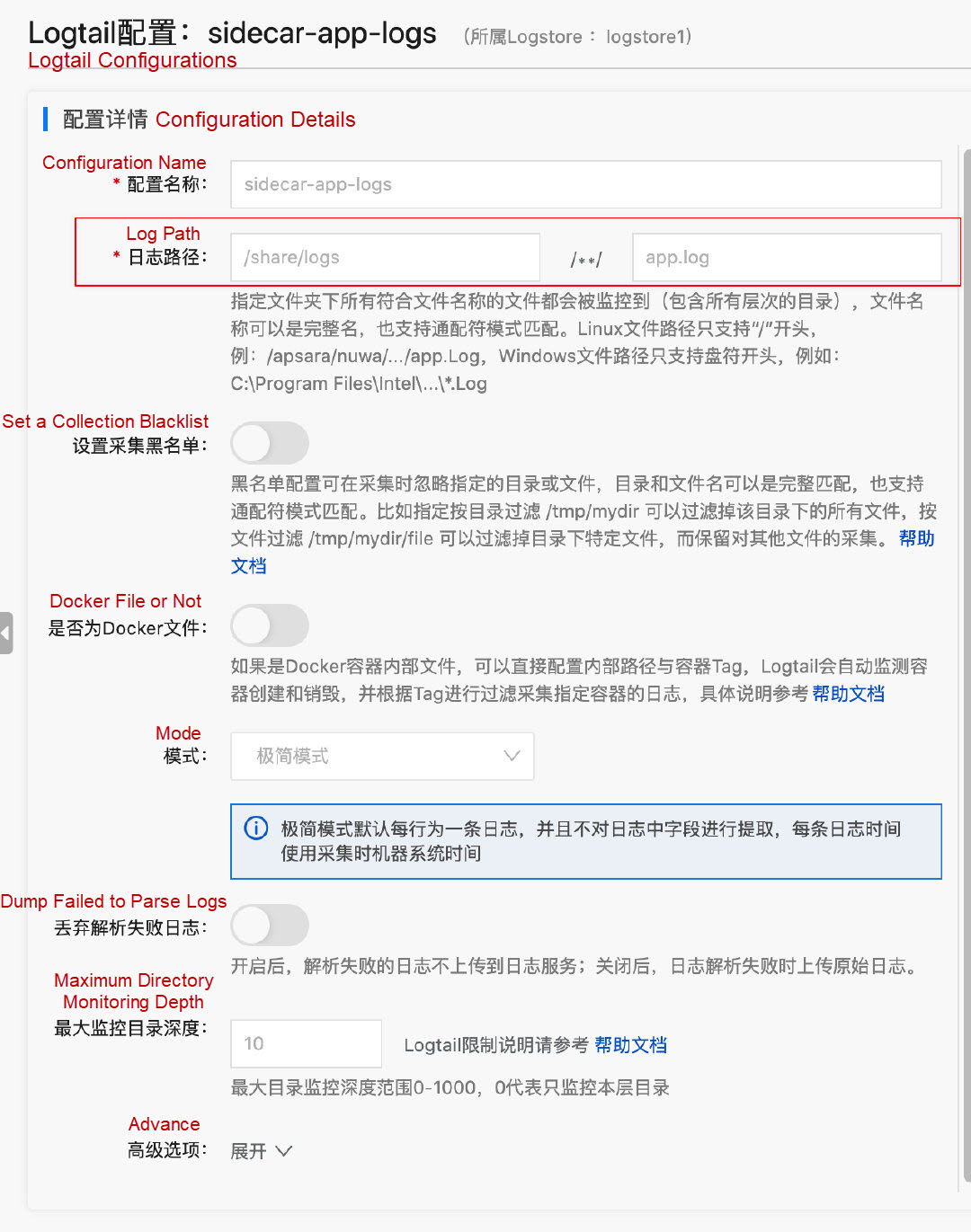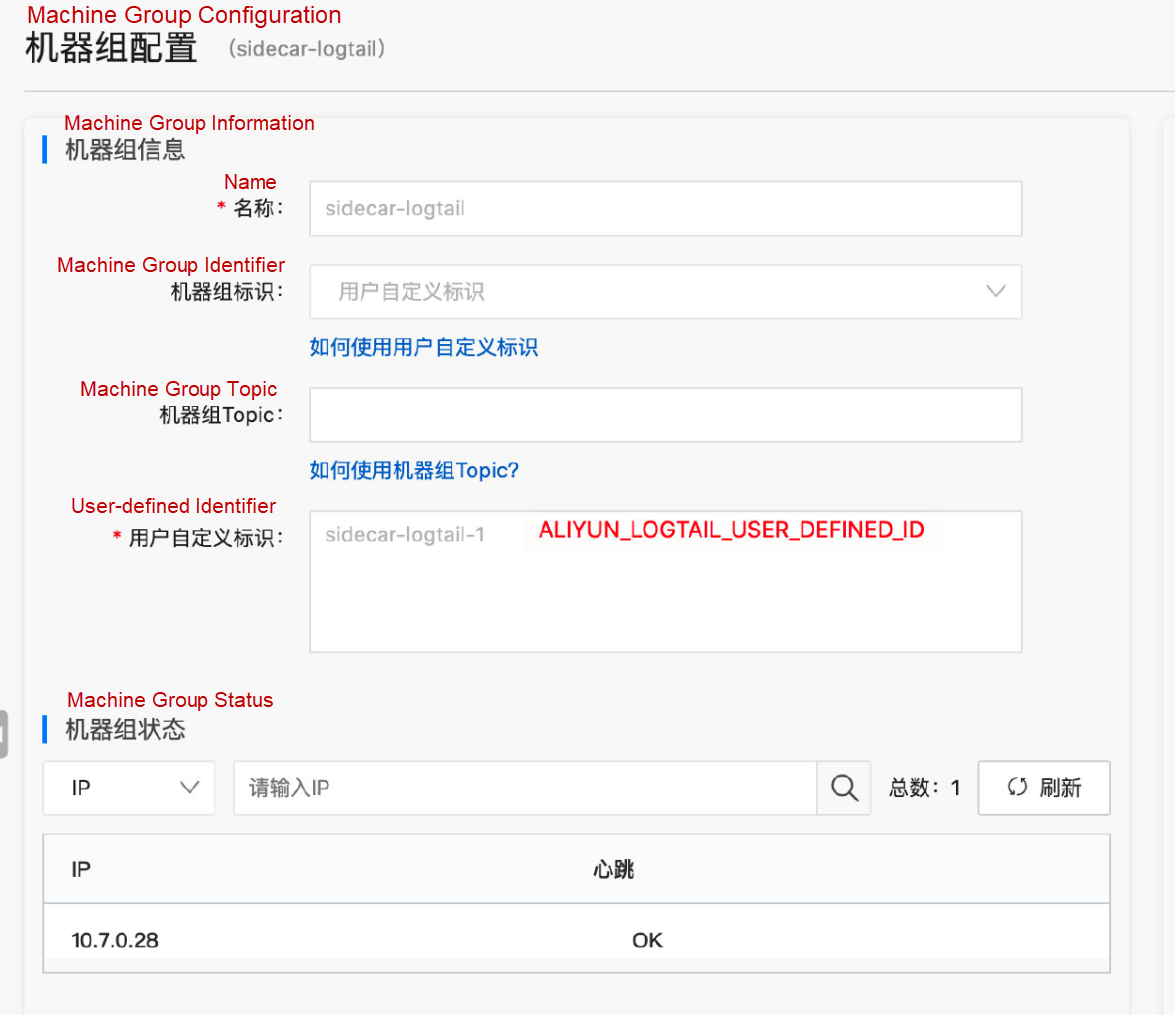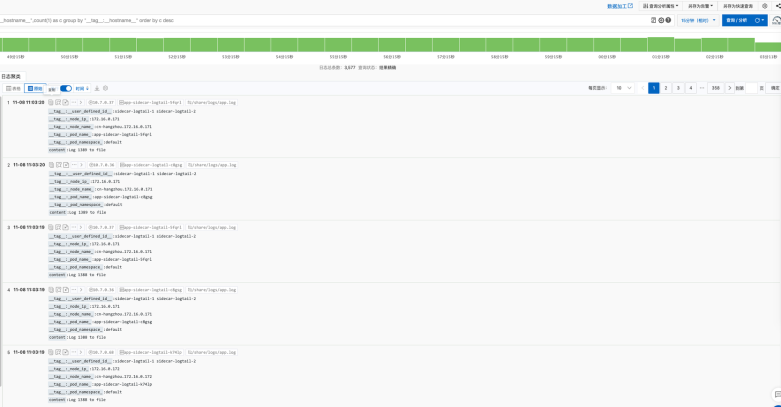By Baoze
The advantage of DaemonSet is that it can minimize the resources occupied by agent collection and support stdout collection. However, the DaemonSet pod needs to be responsible for node-level data collection, so different pods on the same node may affect each other. For example, a pod with a large amount of data processed may consume more logtail processing timeslices, affecting data collection of other pods.
Therefore, we recommend using Sidecar to deploy logtail for business files with important data. That means adding another container to the business pod to run logtail and focusing on file collection of the pod.
Considering the high requirements for data security when using Sidecar for collection, this article introduces the configuration of hostPath volume based on Sidecar to ensure data security in extreme cases (node downtime, pod crash, etc.). A sample application (Dockerfile) and the corresponding deployment configuration (YAML) will be given to facilitate readers to build on it. This will make the content easier to understand and practice.
First, think about the pod crash scenarios. Files generated by business containers in pods are temporary by default. When there is a pod crash, these files will be lost. A method for avoiding the loss is to mount them to persistent volumes and decouple data from the pod lifecycle.
This article uses the hostPath to mount the data directory of the pod to the host (node) where the pod runs. Since multiple business pods will run on one node, we need to do some space partitioning. It is feasible to define a data directory (e.g., /data) on the host, and each pod creates a subdirectory at runtime under this data directory as its data space (such as /data/<pod_name>). The pod can divide this data space based on the needs, such as creating a logs directory for storage and a data directory to store the data generated by the business logic.
Based on the hostPath + host data directory method, the solution to node downtime is easy: decouple the data directory from the node, such as using a cloud disk as the data directory. As such, it doesn't matter whether the node crashes or not. You can pull a new node and mount the cloud disk to it to recover the data. Please see Disk volume overview for more information.
A sample application and its deployment configuration (source code) are presented below to illustrate the preceding design further.
The application logic is simple. First, create the corresponding pod data directory and then generate logs:
#!/bin/bash
echo "Data directory: ${POD_DATA_DIR}"
# Create a specified log directory based on environment variables (a data directory is created by the way).
# If the directory already exists, it means a conflict occurs. Combine the current date and time and adjust the environment variables.
if [ -d ${POD_DATA_DIR} ]; then
echo "Existing data directory ${POD_DATA_DIR}, concat timestamp"
POD_DATA_DIR="${POD_DATA_DIR}-$(date +%s)"
echo "New data directory: ${POD_DATA_DIR}"
fi
POD_LOG_DIR="${POD_DATA_DIR}/logs"
mkdir -p ${POD_LOG_DIR}
# Create a symbolic link to unify the log paths in the logtail collection configuration.
ln -s ${POD_LOG_DIR} /share/logs
# Generate logs.
LOG_FILE_PATH=${POD_LOG_DIR}/app.log
for((i=0;i<10000000000000;i++)); do
echo "Log ${i} to file" >> ${LOG_FILE_PATH}
sleep 1
doneThe sample code run.sh includes the following steps:
POD_DATA_DIR (specified in the deployment configuration)POD_LOG_DIR directoryCombined with the Dockerfile, we package run.sh as an application image. URL: registry.cn-hangzhou.aliyuncs.com/log-service/docker-log-test:sidecar-app
FROM registry.cn-hangzhou.aliyuncs.com/log-service/centos:centos7.7.1908
ADD run.sh /run.sh
RUN chmod +x /run.sh
ENTRYPOINT ["/run.sh"]Finally, let's look at the deployment configuration (YAML) of the application:
apiVersion: v1
kind: Pod
metadata:
# The suffix is not fixed. The name is randomly generated.
generateName: app-sidecar-logtail-
namespace: default
spec:
volumes:
# Define the shared directory of the application container and the Logtail Sidecar container.
- emptyDir: {}
name: share
# Define the data directory on the host. The application container will create a subdirectory under the directory as its data directory.
- hostPath:
path: /data
type: DirectoryOrCreate
name: parent-data-dir-on-host
containers:
# The application containers output logs in file format.
- name: app
# The execution logic of the application:
#1. Create the corresponding subdirectory under the host data directory as its data directory.
#2. Create the corresponding symbolic link for the data directory and share it with the Sidecar container through the shared directory.
#3. Execute the application logic (to continuously generate mock data).
# Refer to the directory app for the Dockerfile and startup script of this image.
image: registry.cn-hangzhou.aliyuncs.com/log-service/docker-log-test:sidecar-app
imagePullPolicy: Always
volumeMounts:
# Mount the shared directory to share data with the Sidecar container.
- mountPath: /share
name: share
# Mount the host data directory to create the corresponding subdirectory.
- mountPath: /data
name: parent-data-dir-on-host
env:
# Obtain the PodName to create the corresponding data directory for the pod on the host.
- name: POD_NAME
valueFrom:
fieldRef:
fieldPath: metadata.name
- name: POD_DATA_DIR
value: /data/$(POD_NAME)Pay attention to the configuration of the following two parts:
POD_NAME, POD_DATA_DIR: Here, we use the pod name as the name of the pod data directory and create the corresponding subdirectory under the parent directory.Next, add the Sidecar configuration to the preceding application deployment configuration. Here, we take logtail as an example (The configuration can be adjusted for other agents based on the files). The complete configuration is listed below:
apiVersion: v1
kind: Pod
metadata:
# The suffix is not fixed. The name is randomly generated.
generateName: app-sidecar-logtail-
namespace: default
spec:
volumes:
# Define the shared directory of the application container and the Logtail Sidecar container.
- emptyDir: {}
name: share
# Define the data directory on the host. The application container will create a subdirectory under the directory as its data directory.
- hostPath:
path: /data
type: DirectoryOrCreate
name: parent-data-dir-on-host
containers:
# The application containers output logs in file format.
- name: app
# The execution logic of the application:
#1. Create the corresponding subdirectory under the host data directory as its data directory.
#2. Create the corresponding symbolic link for the data directory and share it with the Sidecar container through the shared directory.
#3. Execute the application logic (to continuously generate mock data).
# Refer to the directory app for the Dockerfile and startup script of this image.
image: registry.cn-hangzhou.aliyuncs.com/log-service/docker-log-test:sidecar-app
imagePullPolicy: Always
volumeMounts:
# Mount the shared directory to share data with the Sidecar container.
- mountPath: /share
name: share
# Mount the host data directory to create the corresponding subdirectory.
- mountPath: /data
name: parent-data-dir-on-host
env:
# Obtain the PodName to create the corresponding data directory for the pod on the host.
- name: POD_NAME
valueFrom:
fieldRef:
fieldPath: metadata.name
- name: POD_DATA_DIR
value: /data/$(POD_NAME)
# The Logtail Sidecar container shares the log directory with the application container to collect logs.
- name: logtail
image: registry-vpc.cn-hangzhou.aliyuncs.com/log-service/logtail:v1.0.25.0-eca7ef7-aliyun
volumeMounts:
# Mount the shared directory in a read-only manner to obtain log data.
- mountPath: /share
name: share
readOnly: true
- mountPath: /data
name: parent-data-dir-on-host
readOnly: true
env:
# Attach pod-related properties to each log for traceability.
# Modify the values of the ALIYUN_LOG_ENV_TAGS to add or delete fields as needed. Separate fields with |.
# For more information about how to get pod properties, see: https://kubernetes.io/zh/docs/tasks/inject-data-application/environment-variable-expose-pod-information/
- name: ALIYUN_LOG_ENV_TAGS
value: _node_name_|_node_ip_|_pod_name_|_pod_namespace_
- name: _node_name_
valueFrom:
fieldRef:
apiVersion: v1
fieldPath: spec.nodeName
- name: _node_ip_
valueFrom:
fieldRef:
apiVersion: v1
fieldPath: status.hostIP
- name: _pod_name_
valueFrom:
fieldRef:
fieldPath: metadata.name
- name: _pod_namespace_
valueFrom:
fieldRef:
fieldPath: metadata.namespace
# Set the configuration file used by Logtail to access the specified region of SLS.
# Rule: /etc/ilogtail/conf/<region>-<network_type>/ilogtail_config.json
# - <region> indicates a region, such as cn-hangzhou, cn-shanghai.
# - <network_type> indicates the network type used, including intranet, internet, and acceleration.
# Example:
# - Access Hangzhou public cloud by internet: /etc/ilogtail/conf/cn-hangzhou-internet/ilogtail_config.json
# - Access Shanghai public cloud by acceleration: /etc/ilogtail/conf/cn-shanghai-acceleration/ilogtail_config.json
- name: ALIYUN_LOGTAIL_CONFIG
value: '/etc/ilogtail/conf/cn-hangzhou-internet/ilogtail_config.json'
# Set the user-defined identifiers of the Logtail instance to associate the machine group and obtain the collection configuration. You can set multiple of it and use the comma (,) to separate them.
- name: ALIYUN_LOGTAIL_USER_DEFINED_ID
value: sidecar-logtail-1,sidecar-logtail-2
# Set the ALIUID to access the corresponding SLS project. You can set multiple ALIUIDs and use the comma (,) to separate them.
- name: ALIYUN_LOGTAIL_USER_ID
value: "123456789"
# For more startup parameters, please refer to https://help.aliyun.com/document_detail/32278.html
- name: cpu_usage_limit
value: "2.0"
- name: mem_usage_limit
value: "1024"The complete deployment configuration mainly adds the processes after -name: logtail. Similar to the application configuration, there are two parts:
Save the complete configuration above as the sidecar.yaml and use the kubectl create -f sidecar.yaml to create an application pod:
$for((i=0;i<4;i++)); do kubectl create -f sidecar.yaml; done
pod/app-sidecar-logtail-c8gsg created
pod/app-sidecar-logtail-k74lp created
pod/app-sidecar-logtail-5fqrl created
pod/app-sidecar-logtail-764vm created
$kubectl get pods -o wide
NAME READY STATUS RESTARTS AGE IP NODE NOMINATED NODE READINESS GATES
app-sidecar-logtail-5fqrl 2/2 Running 0 16s 10.7.0.37 cn-hangzhou.172.16.0.171 <none> <none>
app-sidecar-logtail-764vm 2/2 Running 0 15s 10.7.0.70 cn-hangzhou.172.16.0.172 <none> <none>
app-sidecar-logtail-c8gsg 2/2 Running 0 16s 10.7.0.36 cn-hangzhou.172.16.0.171 <none> <none>
app-sidecar-logtail-k74lp 2/2 Running 0 16s 10.7.0.68 cn-hangzhou.172.16.0.172 <none> <none>There are two pods on each node. We can choose one pod and enter the app container to view the data directory.
$kubectl exec -it app-sidecar-logtail-5fqrl -c app bash
[root@app-sidecar-logtail-5fqrl /]# ls -al /data/
total 16
drwxr-xr-x 4 root root 4096 Nov 8 02:40 .
drwxr-xr-x 1 root root 4096 Nov 8 02:40 ..
drwxr-xr-x 3 root root 4096 Nov 8 02:40 app-sidecar-logtail-5fqrl
drwxr-xr-x 3 root root 4096 Nov 8 02:40 app-sidecar-logtail-c8gsg
[root@app-sidecar-logtail-5fqrl /]# tail /share/logs/app.log
Log 120 to file
Log 121 to file
Log 122 to file
Log 123 to file
Log 124 to file
Log 125 to file
Log 126 to file
Log 127 to file
Log 128 to file
Log 129 to fileHere is a brief description of the configuration process:

We use /share/logs/app.log as the collection target.
Here is the explanation of the share mount that is not explained earlier. The names of each pod data directory are dynamic in the preceding processes, but they are all created with the same sidecar.yaml. Logically, they belong to the same application. Generally speaking, we prefer to use the SLS collection configuration for each application to realize the collection, no matter how many pods there are. Therefore, we added the share mount and /share/logs symbolic link to mask the dynamic directories of each pod.

Note: You need to create the machine group with user-defined identifiers (consistent with the ALIYUN_LOGTAIL_USER_DEFINED_ID in the configuration) to logically distinguish sidecar logtail instances generated by different applications and send different collection configurations to these instances to avoid conflicts.
After completing the configuration in the SLS console and sending the collection configuration to the logtail instance, you can query the corresponding logs in the console (index must be enabled).

You can easily distinguish the source of each piece of data with the pod fields (pod_name, etc.) we attached.
With the aforementioned design, we ensure that business data will not be lost in extreme cases. This design requires some additional work, including:
Comprehensive Analysis of Kubernetes Log Collection Principles

222 posts | 33 followers
FollowAlibaba Container Service - October 13, 2022
Apache Flink Community China - November 6, 2020
Alibaba Developer - March 31, 2020
Alibaba Developer - April 22, 2021
Alibaba Container Service - January 10, 2025
Alibaba Developer - April 15, 2021

222 posts | 33 followers
Follow ACK One
ACK One
Provides a control plane to allow users to manage Kubernetes clusters that run based on different infrastructure resources
Learn More Container Service for Kubernetes
Container Service for Kubernetes
Alibaba Cloud Container Service for Kubernetes is a fully managed cloud container management service that supports native Kubernetes and integrates with other Alibaba Cloud products.
Learn More Function Compute
Function Compute
Alibaba Cloud Function Compute is a fully-managed event-driven compute service. It allows you to focus on writing and uploading code without the need to manage infrastructure such as servers.
Learn More Elastic High Performance Computing Solution
Elastic High Performance Computing Solution
High Performance Computing (HPC) and AI technology helps scientific research institutions to perform viral gene sequencing, conduct new drug research and development, and shorten the research and development cycle.
Learn MoreMore Posts by Alibaba Container Service